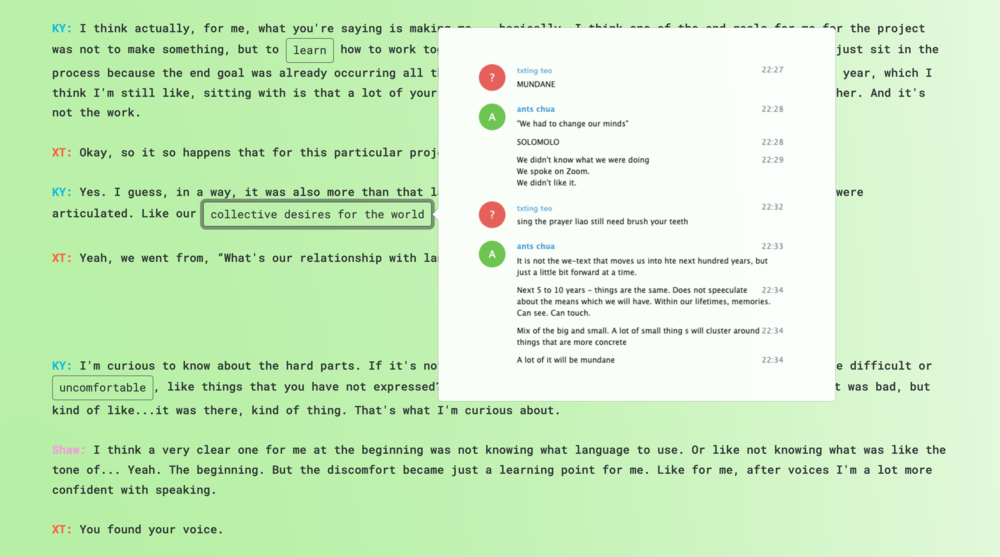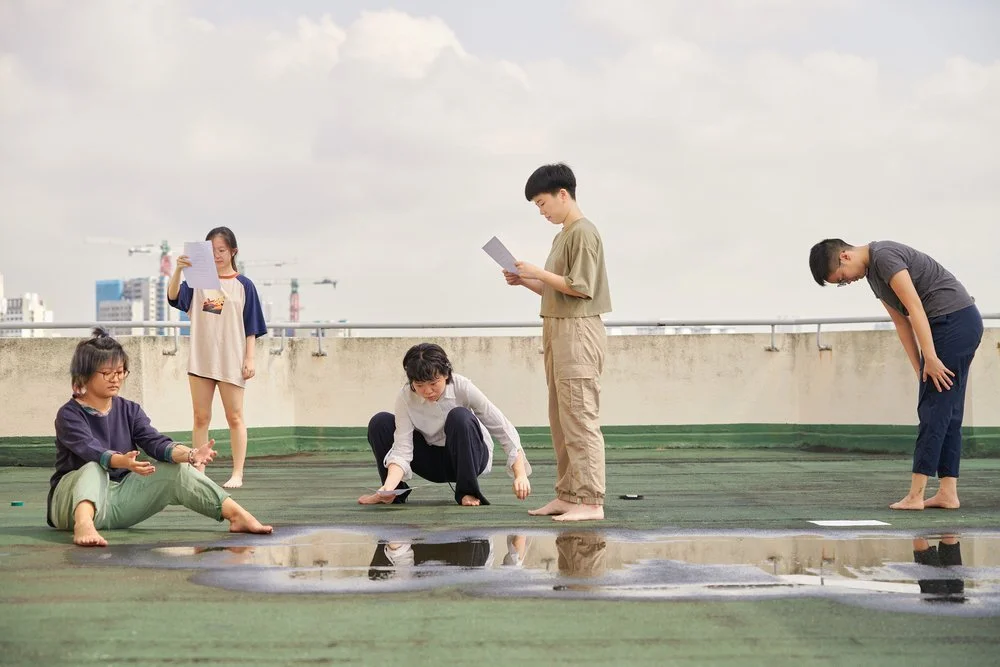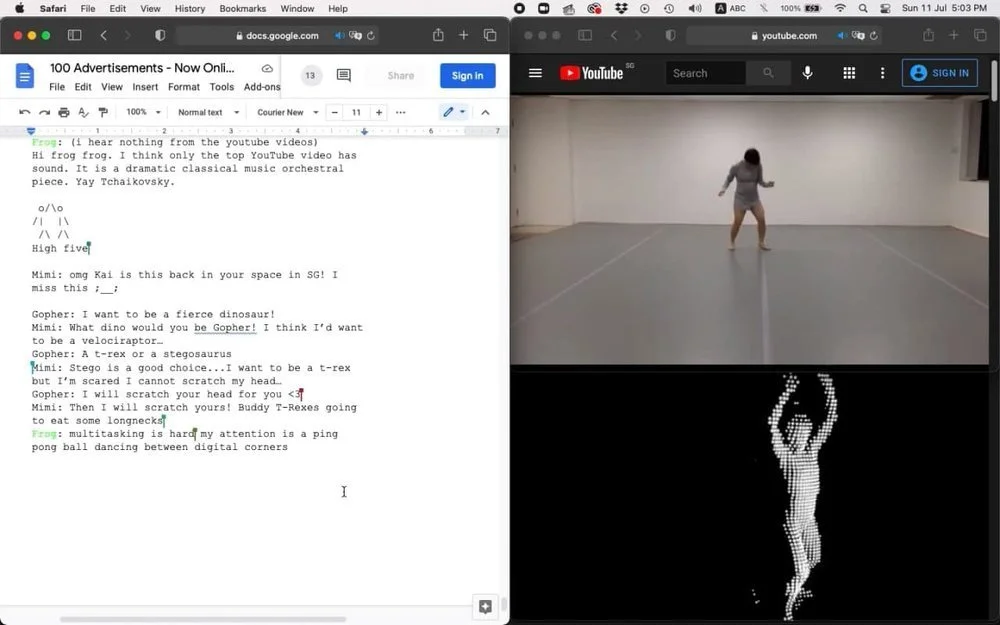Integrating Performance Art and Technology
Case Study: Feelers
The mediums of performance art and technology form an intriguing combination. While performance art is traditionally experienced in-person, online interactions are indirect. Given the necessary distance that the pandemic has imposed on us, how have performance artists been using technology to close the gap and reach audiences? In what ways does technology help in the archiving of performance artwork? With these questions in mind, I chanced upon Feelers, a Singapore-based studio running a Labs programme that nurtures the integration of performance art and technology. In this article, I write about my experience of three of their works: Across a Small Distance, 100 Advertisements - Now Online! and voices in a room.
Run by Ang Kia Yee, Seet Yun Teng and Ashley Hi, Feelers is housed within an international group of companies called Potato Productions. The group spans various industries from healthcare to gaming, and focuses on creating positive social impact in innovative ways. “Lee Han Shih, the founder of Potato Productions, was interested in how technology could be used to address the restrictions and potentially arrive at new forms of art,” shares Kia Yee, Performance Artist and Project Lead of Feelers. “When he spoke to me about this, I was wary about interfacing with technology but I also recognised the need to invent other means for remote performances to occur.” Feelers was then born with a versatile presence across online and offline spaces, welcoming experimentation, interdisciplinary practices and social good.
Medium as Message
Under its Labs programme, Feelers has supported three proposals that purposefully integrate performance art and technology. The latest completed project, titled Across a Small Distance, was performed in-person at starch by artists Chew Shaw En and Jevon Chandra. By merging elements of live performance, visual projection and radio transmissions, the work explores the complexities of communicating in a digital era. “Technology is usually expected to bridge large distances, repair transnational crises and reach a planetary scale,” reflects Jevon. “I want to remember that disconnection and repair also happen on the side of the small, mundane and physically proximate.”
In September this year, I had the privilege of watching Across a Small Distance in person. I understood the work as two humans trying to speak to one another without speech. With acceptance and struggle, the performers communicated through the two mediums we are most familiar with – the body and technology. We as audience members were free to move around the space in any way we pleased. While technology may seem to be an impersonal medium, Shaw observes that digital elements have an “emotional resonance” that has to be learned and brought together with the body in performance. As she points out, “technology has ironically been more intimate to us than the body is”, an idea that holds true especially during the pandemic.
Performance screenshot of 100 Advertisements - Now Online! (2021), captured by Seet Yun Teng. Image courtesy of Feelers.
Another project housed by Feelers is a 90-minute work by dancer Eng Kai Er titled 100 Advertisements - Now Online!, which was adapted for online viewing from an existing piece. Instead of simply streaming a physical performance, which I observe to be more common in digital exhibitions, Kai Er consciously made it as an entirely online work. “I wanted to make it interactive without being imposing,” explains the artist. “The audience could participate if they wanted to; there was a reason for us all to meet at a specific time and do something together.”
To convey her ideas, Kai Er used three elements: a live performance over Zoom with real-time improvisations, pre-recorded YouTube videos of imaginary advertisements, and Google Docs to engage with audiences throughout. Honoring the digital medium, she likewise conducted rehearsals over Zoom with the Feelers team, who made comments entirely online. Together, they used technology in service of the work’s message, addressing issues of Covid-19, politics and travel through advertisements, which are usually experienced over screens in daily life.
Documentation of the group's private rehearsal of the performance scores for voices in a room, shot by Rice Tan. Image courtesy of Feelers.
The third project nurtured by Feelers is voices in a room by Kia Yee, ants chua, Shaw, Helen Cai, Rice Tan and Teo Xiao Ting. Curiously, this work is neither an online nor in-person performance. Instead, I signed up to have five different ‘score sheets’ sent directly to me. They include straightforward directions such as “2 head shakes”, interactive motions like “Shout ‘flower!’when you see someone jump” and metaphorical ones such as “Knead your body into dough”. I, and other participants across the world can then use these scores to perform the work ourselves, whether in private or in public.
When asked about the medium, Kia Yee explained “Due to the changing restrictions, we ultimately turned back to the simple technology of print and post to convey a prototypal form of our envisioned work.” Although this choice was largely pushed by the pandemic, I thought the medium was wholly suitable to the work’s theme of collaboration and deepening relationships. By allowing us to perform the scores ourselves, voices in a room encourages us to engage directly with one another, rather than be passive observers. When time allows, the artists will further develop the work into a live participatory experience that will activate their performance scores and involve more technological meditations.
Documentation as a Subjective Practice
There has been a rise of art websites, much like feelers-feelers.com, that are characterised by unconventional layouts, neon colours and unexpected button locations. Some other similar web pages were made by individuals such as artist art naming, and institutions like Yale School of Art. I see these website designs as a soft rebellion against overt structure, a celebration of messiness and organic interactions.
Executed by an external designer, the Feelers website has a green background with a centre gradient emanating from the user’s cursor. “Our focus was to find a suitable brand colour that aligned with the vision of a morphing project,” relates Kia Yee. “We chose a green colour that was drawn from printed circuit boards (PCB), which sits between the technological and biological, as well as the focused and adaptive realms.” Indeed, as I move my cursor around the Feelers website, the background shifts with me, signalling a sense of fluidity.
Using the website aesthetic to their advantage, Feelers documents performance art in unconventional ways, paying close attention to the “slow process of experimentation” that comes with art-making. Each documentation includes a myriad of digital materials that build a larger picture of the process. “Archives often aspire to be comprehensive, neutral and detached,” elucidates Yun Teng, Documentation Lead of Feelers. “I am more interested in how our attempts at documentation will always be incomplete and subjective; my aim is to draw out the immaterial aspects of the process, presenting glimpses into how conversations developed, ideas shifted and creative decisions were made.”
Screenshot of the documentation page for voices in a room.
The documentation of voices in a room is anchored in a transcription of a post-mortem conversation between the performance artists involved. While reading their reflections, I can click on certain phrases to reveal further conversations and images. This includes screenshots of telegram chat histories, images, documents, rehearsal notes and videos. “The content of the popovers are not always directly connected with the ongoing conversation,” describes Yun Teng. “I wanted to use these words and phrases to draw out emotional links.” Throughout the process, the team members were constantly sharing articles, poems and artworks that inspired them. Although these references were not always directly connected to the ongoing discussion, they found their way into the final work. The documentation of voices in a room then mirrors its process, where conversation and organic mental connections are placed at the forefront.
Eng Kai Er, 100 Advertisements - Now Online!. Video courtesy of the artist.
Embodying a more instinctive layout, the documentation of 100 Advertisements - Now Online! does not focus on a single element but rather, incorporates a mix of conversation excerpts, quotations, images, videos and feedback from the audience. These elements are scattered across the page in a slightly chaotic manner, requiring us to adopt an explorative mindset to absorb the information presented. Among them is an intriguing Chrome extension called Draftback that allows users to play back the revision history of a Google Doc in real-time. “Much like Kai’s process, the layout is more playful and organic,” says Yun Teng. “Google Docs was a key platform that Kai used and hence, we tested using Draftback to trace the energy and interactions that took place during the live performances.” Truly, the documentation page captures Kai Er’s energy, an immaterial aspect that would inevitably be muted in a conventional archive.
What is the future of performance art in a post-Covid world? Feelers explores this question deeply through experimentation. Whether in art-making or documenting, their Labs projects address topics such as human connection, communication and mass media, all of which hold relevance in our time of global digitalisation. Though not without the privilege of time and funding, the studio’s valuing of a slow and intentional process might be much needed in today’s fast-paced landscape; their contributions expand the boundaries of performance art, creating more possibilities as we continue to navigate the push and pull of offline and online formats.
More information on Feelers can be found here.



